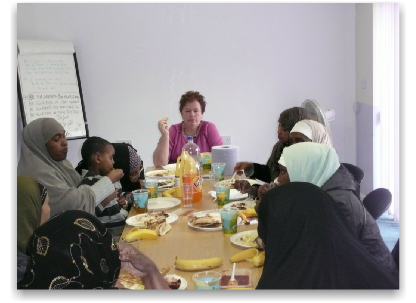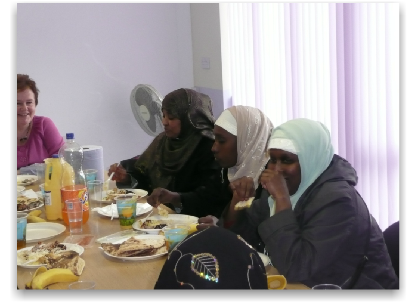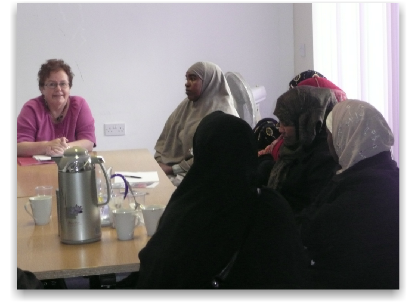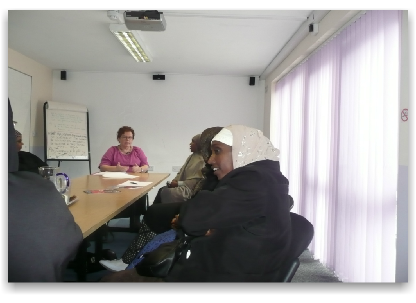
SOMALI CULTURAL RESOURCE CENTRE - COVENTRY
We Positively Integrate With Other Communities.
Youth Programme
Youth Programme
Youth Programme
Womens Programme
Womens Programme
Womens Programme
Khat Awareness
Khat Awareness
Khat Awareness

We run four different youth programs, which are aimed at our users(The Somali youth) so they can easily integrate into the wider UK community and hopefully in future to take part in the nation building of our host country(UK).
The program are:
1. youth club
2. football team
3. Making changes project (Drug prevention program)
4. work placement opportunities
The club is attended regularly by about 30 youths every evening. The facilities we have are football table, snooker/pool table, table tennis, TV & video. All this equipment has been paid for by a grant from Awards for all.
The football team comprises of 25 young men, our football team participated in a tournament and we reached up to the semi finals. Once again, all the football kits including the footballs have been paid for by a grant from Awards for all.
The making changes project aims preventing the Somali youths from using a stimulant and a narcotic leaf called Ghat. This project is helping both boys and girls age 13 to 25 years old who are either already using the stimulant and narcotic leaf or those who are likely to use it in the near future.
In the work placement program, we aim to help the Somali children who are in the local schools to find work placement opportunities either in our organisation or with external organisation that we have established relationship with. This financial year we were able to internally accommodate four boys and two girls in our centre and we further managed to find work placement for a further seven children with external organisation.
We provide various programmes for women from learning the English language to skill building workshops to help you find work and empower yourself whilst contributing to society. We work with various organisations and provide Esol classes for people whose first language is not English.
We provide workshops for C.V. building as well as teaching you interview techniques and help you to prepare for them and how to improve your chances of securing that job!
Whatever your needs may be, even if it is a quick chat for some advice, we are here to help. If you would like to talk to us please do not hesitate to contact us.




Womens Workshop 1
Womens Workshop 2
Womens Workshop 3
Womens Workshop 4
Previous
Next
1 of 4




The Khat Awareness project

The Khat Awareness Project was initiated as a sudden rise in the number of cases of people using khat had become substantial leading to many problems for people within the Somali community who were regular users of Khat. It was therefore imperitive to make people aware of the side affects of using this substance.
An annual Khat awareness programme takes place to educate and provide further information about how Khat can affect individuals as well as families and how we can help users to overcome and quit the use of Khat. Below we have provided a brief background about what Khat is and its affects. If you would like further information or require help, or maybe you know someone who uses Khat, then please do not hesitate to contact us so that we may help.
Khat, qat, gat or Miraa( /ˈkɑːt/ kaht; Catha edulis, family Celastraceae; Arabic: قات qāt; Hebrew: גת, gat; Somali: qaad) is a flowering plant native to tropical East Africa and the Arabian Peninsula. Its Amharic name in Ethiopia is ጫት.
Khat contains the alkaloid called cathinone, an amphetamine-like stimulant which is said to cause excitement, loss of appetite, and euphoria. In 1980, the World Health Organization classified khat as a drug of abuse that can produce mild to moderate psychological dependence (less than tobacco or alcohol).[1] The plant has been targeted by anti-drug organizations like the DEA.[2] It is a controlled or illegal substance in many countries, but is legal for sale and production in many others.
Effects
Khat consumption induces mild euphoria and excitement. Individuals become very talkative under the influence of the drug. The effects of oral administration of cathinone occur more rapidly than the effects of amphetamine, roughly 15 minutes as compared to 30 minutes in amphetamine. Khat can induce manic behaviors and hyperactivity similar in effects to those produced by amphetamine.[23]
The use of khat results in constipation. Dilated pupils (mydriasis) are prominent during khat consumption, reflecting the sympathomimetic effects of the drug, which are also reflected in increased heart rate and blood pressure.
Withdrawal symptoms that may follow occasional use include mild depression and irritability. Withdrawal symptoms that may follow prolonged khat use include lethargy, mild depression, nightmares, and slight tremor. Khat is an effective anorectic (causes loss of appetite). Long-term use can precipitate the following effects: negative impact on liver function, permanent tooth darkening (of a greenish tinge), susceptibility to ulcers, and diminished sex drive.
Some researchers also say that khat is “an amphetamine-like substance”, and those who use it are more likely to develop mental illnesses. Others say that these mental illnesses are the result of the financial problems and the sleeplessness that the drug causes. But it is still unclear if the consumption of khat directly affects the mental health of the user or not.[16] Occasionally, a psychosis can result, resembling a hypomanic state in presentation.[24]
Regular khat use compromises the ability to inhibit undesirable behavior. Frequent use has been shown to decrease inhibitions, much like the effects of alcohol.[citation needed] It may be associated with a condition similar to autoimmune hepatitis. (wikipedia)